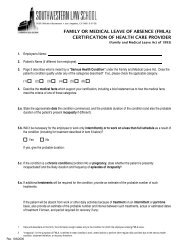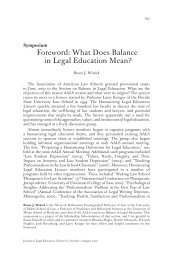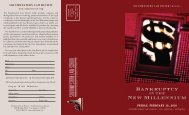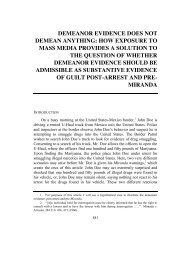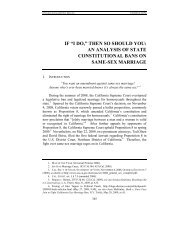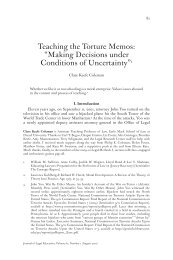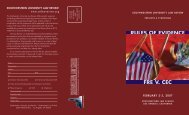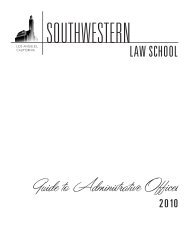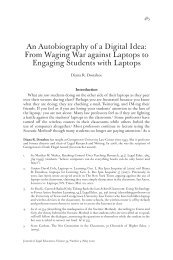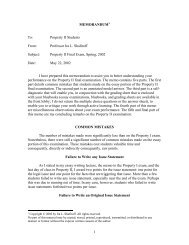What is Art? - Southwestern Law School
What is Art? - Southwestern Law School
What is Art? - Southwestern Law School
- No tags were found...
Create successful ePaper yourself
Turn your PDF publications into a flip-book with our unique Google optimized e-Paper software.
122 J. INT’L MEDIA &ENTERTAINMENT LAW VOL. 4,NO. 2How did courts respond to the ever-changing form and content ofwhat art<strong>is</strong>ts regarded as their art in the late 19th and early 20th century?Our starting point will be consideration of judgment of a work by anearly ‘modern’ art<strong>is</strong>t, James Wh<strong>is</strong>tler. 521878 England: Wh<strong>is</strong>tler v. Ruskin 53Nocturne in Black and Gold: The Falling Rocket (1872–1875) 54 waspainted by Wh<strong>is</strong>tler in oils on canvas. The subject was a night-timefireworks d<strong>is</strong>play over Battersea Bridge in London. The small (23.7inches high by 18.3 inches wide) painting was executed in an impression<strong>is</strong>tic,rather than the (then) orthodox representational, style: it conveyeda sense of atmosphere, with glowing colours and drifting smokeagainst a dark sky over the River Thames. The work was first exhibitedat the prestigious Grosvenor Gallery in London, in a group showthat included paintings by Pre-Raphaelite art<strong>is</strong>ts such as EdwardBurne-Jones. The critic John Ruskin 55 publ<strong>is</strong>hed a review of theshow in one of h<strong>is</strong> popular pamphlets, Fors Clavigera, on 2 July1877. He lauded Burne-Jones and others; but lambasted Wh<strong>is</strong>tler:“For Mr. Wh<strong>is</strong>tler’s own sake, no less than for the protection of thepurchaser, [the Grosvenor Gallery] ought not to have admitted worksinto the gallery in which the ill-educated conceit of the art<strong>is</strong>t so nearlyapproached the aspect of wilful imposture. I have seen, and heard, muchof Cockney impudence before now; but never expected to hear a coxcombask two hundred guineas for flinging a pot of paint in the public’sface.” 56Wh<strong>is</strong>tler’s sales took a sharp downturn after Ruskin’s widely publ<strong>is</strong>hedattack. Wh<strong>is</strong>tler sued for libel, seeking £1,000 for damage to52. James Abbott McNeill Wh<strong>is</strong>tler (1834–1903) was an art<strong>is</strong>t born in Lowell,Massachusetts, who relocated to Europe, Par<strong>is</strong> in particular, eventually settling inLondon. He became widely known through h<strong>is</strong> close association in the 1860s withcontroversial “modern” art<strong>is</strong>ts such as the French Real<strong>is</strong>t painter Gustave Courbetand the Impression<strong>is</strong>t Éduard Manet.53. Officially unreported. The case was tried at the Court of Exchequer Div<strong>is</strong>ionof the High Court in London on 25 and 26 Nov.1978. Wh<strong>is</strong>tler v. Ruskin, THETIMES (LONDON), Nov. 27, 1878, at 9. See also LINDA MERRILL, APOT OF PAINT: AES-THETICS ON TRIAL IN WHISTLER V. RUSKIN (1992).54. It <strong>is</strong> now in the collection of the Detroit Institute of <strong>Art</strong>s, Detroit, Michigan.55. John Ruskin (1819–1900) was a pre-eminent and very influential Brit<strong>is</strong>h art criticof h<strong>is</strong> generation, who professed that an art<strong>is</strong>t’s core function was “truth and nature”. Hewas a staunch defender of then controversial “modern” paintings by J. M. W. Turneragainst fierce critics. He was greatly influenced Pre-Raphaelite painters such as WilliamHolman Hunt, John Everett Milla<strong>is</strong> and Dante Gabriel Rossetti, and founded the Ruskin<strong>School</strong> of Drawing at Oxford University.56. RONALD ANDERSON &ANNE KOVAL, JAMES MCNEILL WHISTLER: BEYOND THEMYTH 215.



